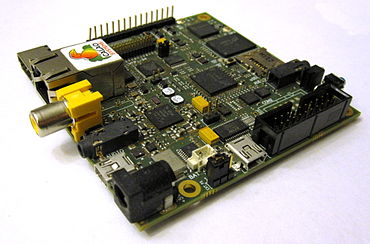 The success of the BeagleBoard platform, a low-cost development platform, that has greatly contributed to the success of Texas Instruments OMAP3 processor in the embedded Linux industry, seems to have inspired another processor manufacturer: ST Ericsson. They have recently unveiled Snowball, a low-cost development platform for their AP9500 processor, which features a dual Cortex A-9 ARM core and a Mali 400 GPU.
The success of the BeagleBoard platform, a low-cost development platform, that has greatly contributed to the success of Texas Instruments OMAP3 processor in the embedded Linux industry, seems to have inspired another processor manufacturer: ST Ericsson. They have recently unveiled Snowball, a low-cost development platform for their AP9500 processor, which features a dual Cortex A-9 ARM core and a Mali 400 GPU.
The development board is designed and produced by our partner Calao Systems, and offers the following features:
- The AP9500 processor, dual Cortex-A9 and Mali 400 GPU
- 4 to 8 GB of e-MMC storage
- 1 GB of LP-DDR2 RAM
- Micro-SD slot
- Ethernet connector, Wifi and Bluetooth
- HDMI output, composite video output
- Audio in/out
- USB On The Go
- Battery charger
- On-board battery to keep time
- Serial port connector, JTAG connector, MiPi 34 debug connector
- Builtin GPS
- 3-axis accelerometer, magnetometer and gyrometer, one pressure sensor
- Expansion connectors to access SPI, I2C, LCD, MiPi devices, GPIO, UART, etc.
- Last but not least, the board can be powered via USB (through a regular cable or through a Y one if power hungry devices like Wifi are used.)
The technical documentation page has a few more details, but at this time, they isn’t a lot of public information available about the AP9500 processor. I hope that ST Ericsson will fully understand how open source works and will soon release datasheets for the AP9500 in an open way. Interestingly, the AP9500 does not use the traditional PowerVR SGX 3D graphics core designed by Imagination Technologies and found in many other ARM processors, but instead uses the Mali graphics core, which is designed directly by ARM. It seems ARM has already open-sourced the kernel side bits of their graphic drivers, but it looks like a proprietary binary blob in userspace is still present.
The board will be available in two variants:
- A Product Development Kit variant for 241 Euros.
- A Software Development Kit variant for 165 Euros. My understanding is that the only difference between the two are the expansion connectors, present on the PDK variant but not on the SDK variant.
The board should be widely available at the end of Q2 2011, i.e around June, though at Bootlin, we will receive our first samples by the end of March thanks to our partnership with Calao Systems. The Snowball platform is supported by the Igloo Community, which hosts mailing-lists, an IRC channel, documentation and will also provide Meego and Android builds for the Snowball in the future.
Stay tuned on this blog. As soon as we get our own boards, we will write about our experiments with them.

Also the PDK is mounted with 8GB eMMC instead of 4MB for the SDK.
/Gael
Forwarding a comment from Philippe Garnier, ST Ericsson…
Dear Thomas ,
Main difference between Snowball SDk and Snowball PDK
Snowball SDK: it’s the SW dev kit as a Panda or a Beagle but with better quality(see below) and features (battery, mems, GPS, eMMC..) . No possibility to resell it in a real product.
Snowball PDK: This has nothing to do with a Beagle or Panda. You can use it as a Module and make real product. It’s very close for our Ref design with a professional design including EMIF, ESD , professional design…That makes the differences . you can take benefit from your innovation!
Why everybody avoids NAND these days??